ACR 212 T1 2019 - Social Media Surveillance Technology Policy Report
VerifiedAdded on 2023/03/30
|11
|2564
|349
Report
AI Summary
This policy report critically analyzes the use, effectiveness, and impacts of social media surveillance technology by law enforcement and security intelligence agencies. The report begins by introducing the prevalence of surveillance techniques in modern society and highlighting the problem statement: the lack of comprehensive methods to assess the societal impacts of surveillance. It explores the negative and positive impacts on citizens' privacy and expression, and the need for transparency and accountability in surveillance practices. The study focuses on surveillance of social media, discussing its role in monitoring and tracking citizens, the use of undercover accounts, and the legal and policy dilemmas it raises. The report examines the technologies used, the increasing volume of data, and the potential for disproportionate effects on specific communities. It delves into the issues and impacts of surveillance technology, referencing Clarke (2011) and Gellert et al. (2011), and emphasizes the importance of conducting Surveillance Impact Assessments (SIA). The report provides recommendations for addressing privacy intrusions and ensuring that surveillance technologies are used responsibly and ethically. The report concludes by emphasizing the importance of balancing the benefits of surveillance with the protection of individual rights.

Surveillance on Social Media
Student Name
Institution Affiliation
Student Name
Institution Affiliation
Paraphrase This Document
Need a fresh take? Get an instant paraphrase of this document with our AI Paraphraser
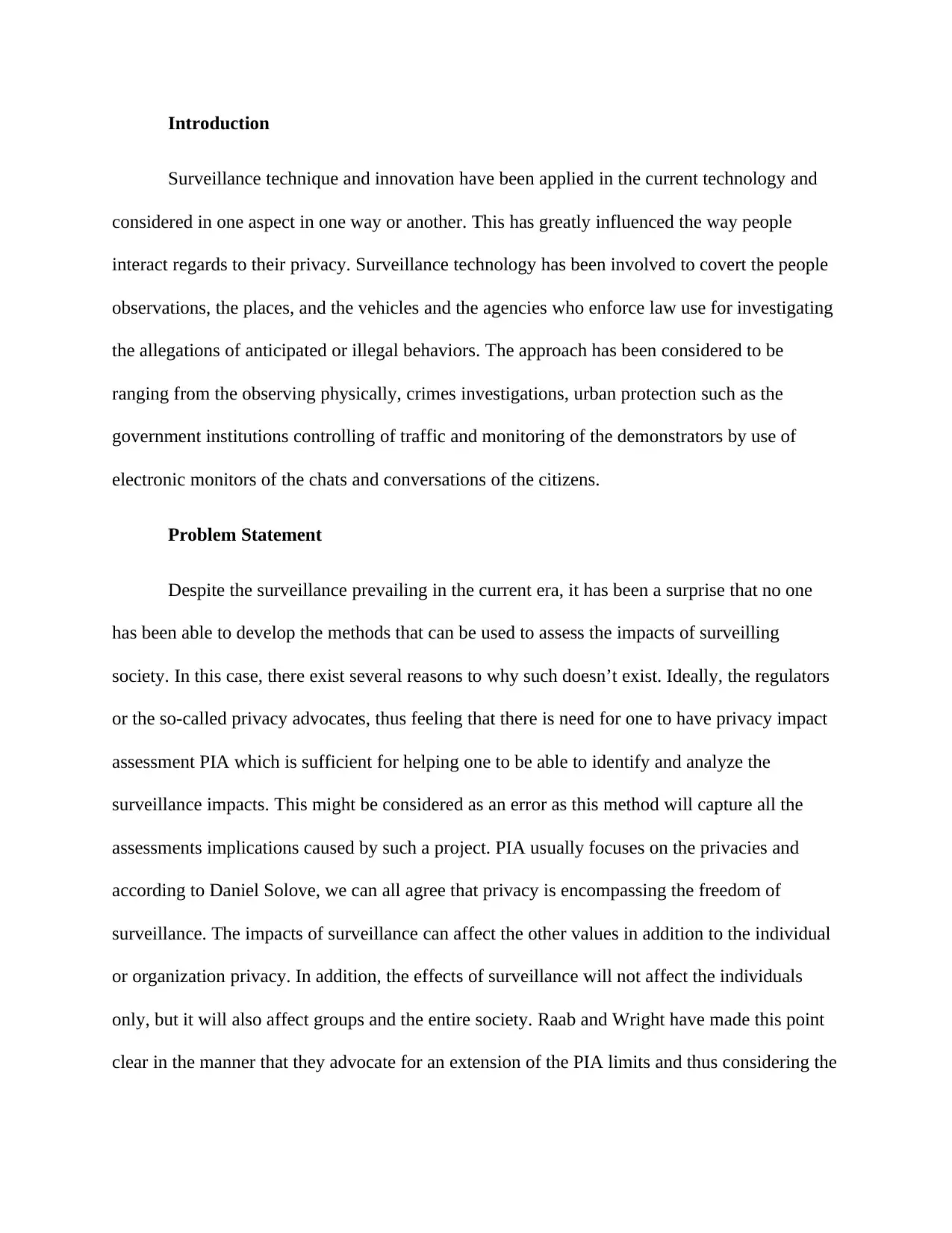
Introduction
Surveillance technique and innovation have been applied in the current technology and
considered in one aspect in one way or another. This has greatly influenced the way people
interact regards to their privacy. Surveillance technology has been involved to covert the people
observations, the places, and the vehicles and the agencies who enforce law use for investigating
the allegations of anticipated or illegal behaviors. The approach has been considered to be
ranging from the observing physically, crimes investigations, urban protection such as the
government institutions controlling of traffic and monitoring of the demonstrators by use of
electronic monitors of the chats and conversations of the citizens.
Problem Statement
Despite the surveillance prevailing in the current era, it has been a surprise that no one
has been able to develop the methods that can be used to assess the impacts of surveilling
society. In this case, there exist several reasons to why such doesn’t exist. Ideally, the regulators
or the so-called privacy advocates, thus feeling that there is need for one to have privacy impact
assessment PIA which is sufficient for helping one to be able to identify and analyze the
surveillance impacts. This might be considered as an error as this method will capture all the
assessments implications caused by such a project. PIA usually focuses on the privacies and
according to Daniel Solove, we can all agree that privacy is encompassing the freedom of
surveillance. The impacts of surveillance can affect the other values in addition to the individual
or organization privacy. In addition, the effects of surveillance will not affect the individuals
only, but it will also affect groups and the entire society. Raab and Wright have made this point
clear in the manner that they advocate for an extension of the PIA limits and thus considering the
Surveillance technique and innovation have been applied in the current technology and
considered in one aspect in one way or another. This has greatly influenced the way people
interact regards to their privacy. Surveillance technology has been involved to covert the people
observations, the places, and the vehicles and the agencies who enforce law use for investigating
the allegations of anticipated or illegal behaviors. The approach has been considered to be
ranging from the observing physically, crimes investigations, urban protection such as the
government institutions controlling of traffic and monitoring of the demonstrators by use of
electronic monitors of the chats and conversations of the citizens.
Problem Statement
Despite the surveillance prevailing in the current era, it has been a surprise that no one
has been able to develop the methods that can be used to assess the impacts of surveilling
society. In this case, there exist several reasons to why such doesn’t exist. Ideally, the regulators
or the so-called privacy advocates, thus feeling that there is need for one to have privacy impact
assessment PIA which is sufficient for helping one to be able to identify and analyze the
surveillance impacts. This might be considered as an error as this method will capture all the
assessments implications caused by such a project. PIA usually focuses on the privacies and
according to Daniel Solove, we can all agree that privacy is encompassing the freedom of
surveillance. The impacts of surveillance can affect the other values in addition to the individual
or organization privacy. In addition, the effects of surveillance will not affect the individuals
only, but it will also affect groups and the entire society. Raab and Wright have made this point
clear in the manner that they advocate for an extension of the PIA limits and thus considering the
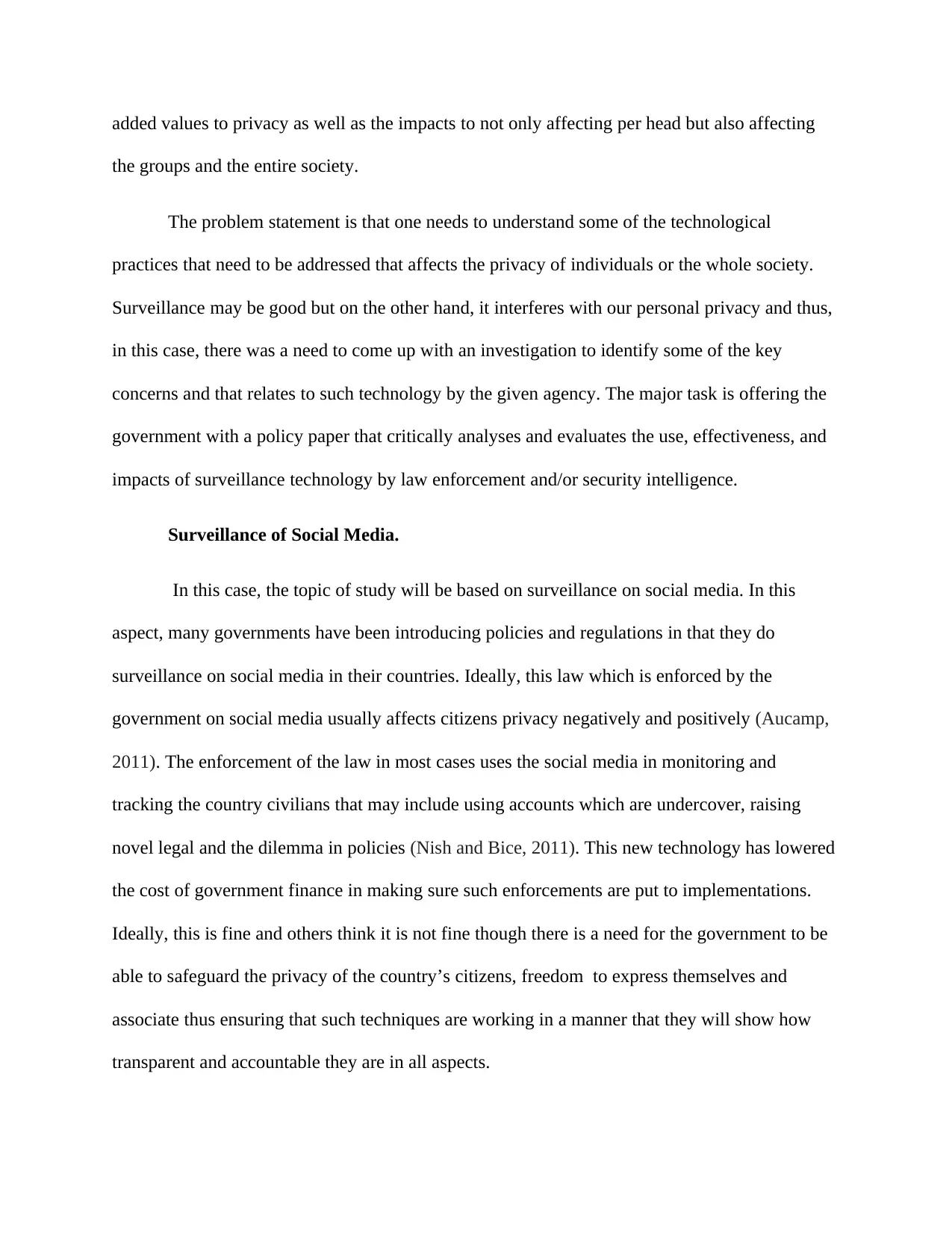
added values to privacy as well as the impacts to not only affecting per head but also affecting
the groups and the entire society.
The problem statement is that one needs to understand some of the technological
practices that need to be addressed that affects the privacy of individuals or the whole society.
Surveillance may be good but on the other hand, it interferes with our personal privacy and thus,
in this case, there was a need to come up with an investigation to identify some of the key
concerns and that relates to such technology by the given agency. The major task is offering the
government with a policy paper that critically analyses and evaluates the use, effectiveness, and
impacts of surveillance technology by law enforcement and/or security intelligence.
Surveillance of Social Media.
In this case, the topic of study will be based on surveillance on social media. In this
aspect, many governments have been introducing policies and regulations in that they do
surveillance on social media in their countries. Ideally, this law which is enforced by the
government on social media usually affects citizens privacy negatively and positively (Aucamp,
2011). The enforcement of the law in most cases uses the social media in monitoring and
tracking the country civilians that may include using accounts which are undercover, raising
novel legal and the dilemma in policies (Nish and Bice, 2011). This new technology has lowered
the cost of government finance in making sure such enforcements are put to implementations.
Ideally, this is fine and others think it is not fine though there is a need for the government to be
able to safeguard the privacy of the country’s citizens, freedom to express themselves and
associate thus ensuring that such techniques are working in a manner that they will show how
transparent and accountable they are in all aspects.
the groups and the entire society.
The problem statement is that one needs to understand some of the technological
practices that need to be addressed that affects the privacy of individuals or the whole society.
Surveillance may be good but on the other hand, it interferes with our personal privacy and thus,
in this case, there was a need to come up with an investigation to identify some of the key
concerns and that relates to such technology by the given agency. The major task is offering the
government with a policy paper that critically analyses and evaluates the use, effectiveness, and
impacts of surveillance technology by law enforcement and/or security intelligence.
Surveillance of Social Media.
In this case, the topic of study will be based on surveillance on social media. In this
aspect, many governments have been introducing policies and regulations in that they do
surveillance on social media in their countries. Ideally, this law which is enforced by the
government on social media usually affects citizens privacy negatively and positively (Aucamp,
2011). The enforcement of the law in most cases uses the social media in monitoring and
tracking the country civilians that may include using accounts which are undercover, raising
novel legal and the dilemma in policies (Nish and Bice, 2011). This new technology has lowered
the cost of government finance in making sure such enforcements are put to implementations.
Ideally, this is fine and others think it is not fine though there is a need for the government to be
able to safeguard the privacy of the country’s citizens, freedom to express themselves and
associate thus ensuring that such techniques are working in a manner that they will show how
transparent and accountable they are in all aspects.
⊘ This is a preview!⊘
Do you want full access?
Subscribe today to unlock all pages.

Trusted by 1+ million students worldwide
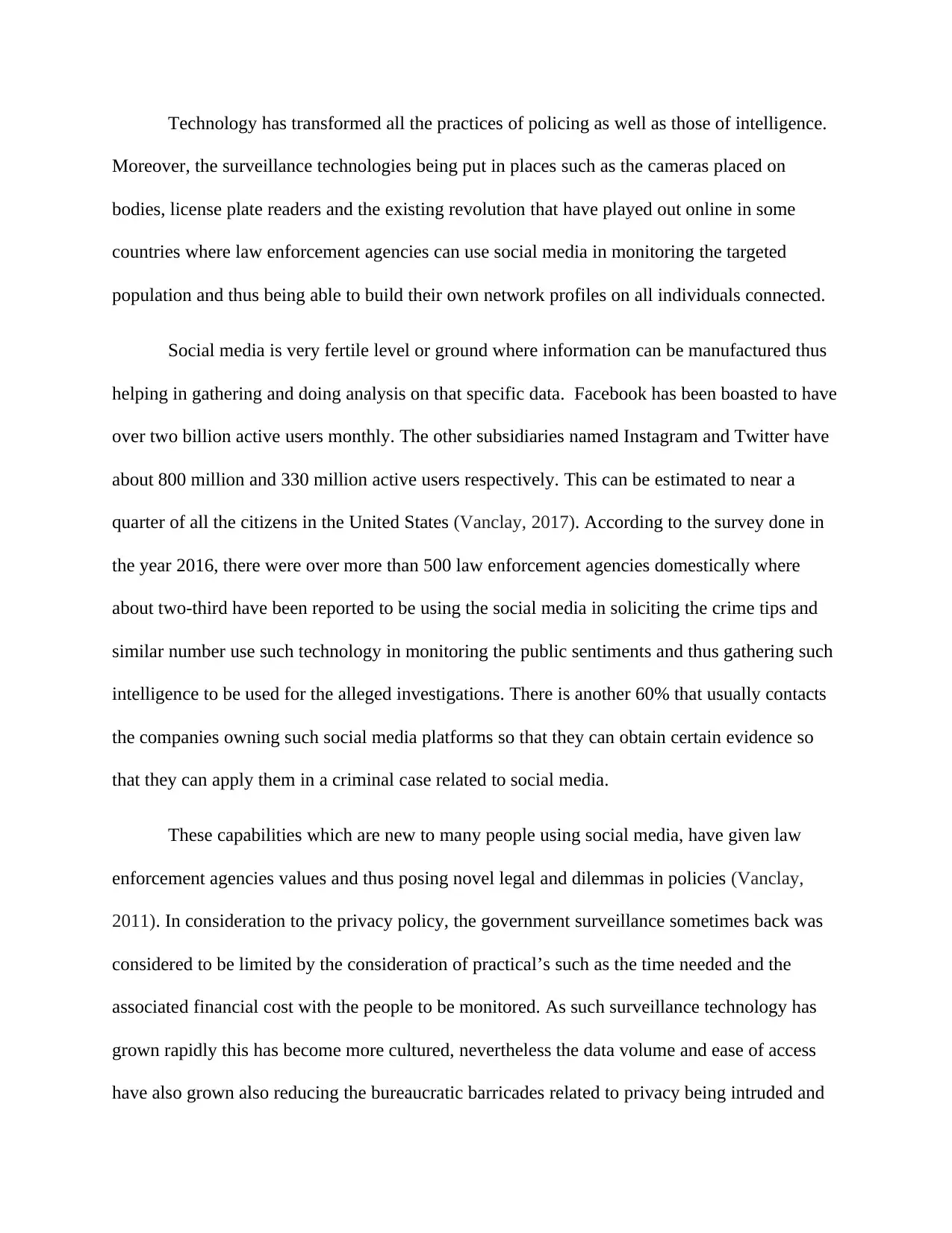
Technology has transformed all the practices of policing as well as those of intelligence.
Moreover, the surveillance technologies being put in places such as the cameras placed on
bodies, license plate readers and the existing revolution that have played out online in some
countries where law enforcement agencies can use social media in monitoring the targeted
population and thus being able to build their own network profiles on all individuals connected.
Social media is very fertile level or ground where information can be manufactured thus
helping in gathering and doing analysis on that specific data. Facebook has been boasted to have
over two billion active users monthly. The other subsidiaries named Instagram and Twitter have
about 800 million and 330 million active users respectively. This can be estimated to near a
quarter of all the citizens in the United States (Vanclay, 2017). According to the survey done in
the year 2016, there were over more than 500 law enforcement agencies domestically where
about two-third have been reported to be using the social media in soliciting the crime tips and
similar number use such technology in monitoring the public sentiments and thus gathering such
intelligence to be used for the alleged investigations. There is another 60% that usually contacts
the companies owning such social media platforms so that they can obtain certain evidence so
that they can apply them in a criminal case related to social media.
These capabilities which are new to many people using social media, have given law
enforcement agencies values and thus posing novel legal and dilemmas in policies (Vanclay,
2011). In consideration to the privacy policy, the government surveillance sometimes back was
considered to be limited by the consideration of practical’s such as the time needed and the
associated financial cost with the people to be monitored. As such surveillance technology has
grown rapidly this has become more cultured, nevertheless the data volume and ease of access
have also grown also reducing the bureaucratic barricades related to privacy being intruded and
Moreover, the surveillance technologies being put in places such as the cameras placed on
bodies, license plate readers and the existing revolution that have played out online in some
countries where law enforcement agencies can use social media in monitoring the targeted
population and thus being able to build their own network profiles on all individuals connected.
Social media is very fertile level or ground where information can be manufactured thus
helping in gathering and doing analysis on that specific data. Facebook has been boasted to have
over two billion active users monthly. The other subsidiaries named Instagram and Twitter have
about 800 million and 330 million active users respectively. This can be estimated to near a
quarter of all the citizens in the United States (Vanclay, 2017). According to the survey done in
the year 2016, there were over more than 500 law enforcement agencies domestically where
about two-third have been reported to be using the social media in soliciting the crime tips and
similar number use such technology in monitoring the public sentiments and thus gathering such
intelligence to be used for the alleged investigations. There is another 60% that usually contacts
the companies owning such social media platforms so that they can obtain certain evidence so
that they can apply them in a criminal case related to social media.
These capabilities which are new to many people using social media, have given law
enforcement agencies values and thus posing novel legal and dilemmas in policies (Vanclay,
2011). In consideration to the privacy policy, the government surveillance sometimes back was
considered to be limited by the consideration of practical’s such as the time needed and the
associated financial cost with the people to be monitored. As such surveillance technology has
grown rapidly this has become more cultured, nevertheless the data volume and ease of access
have also grown also reducing the bureaucratic barricades related to privacy being intruded and
Paraphrase This Document
Need a fresh take? Get an instant paraphrase of this document with our AI Paraphraser
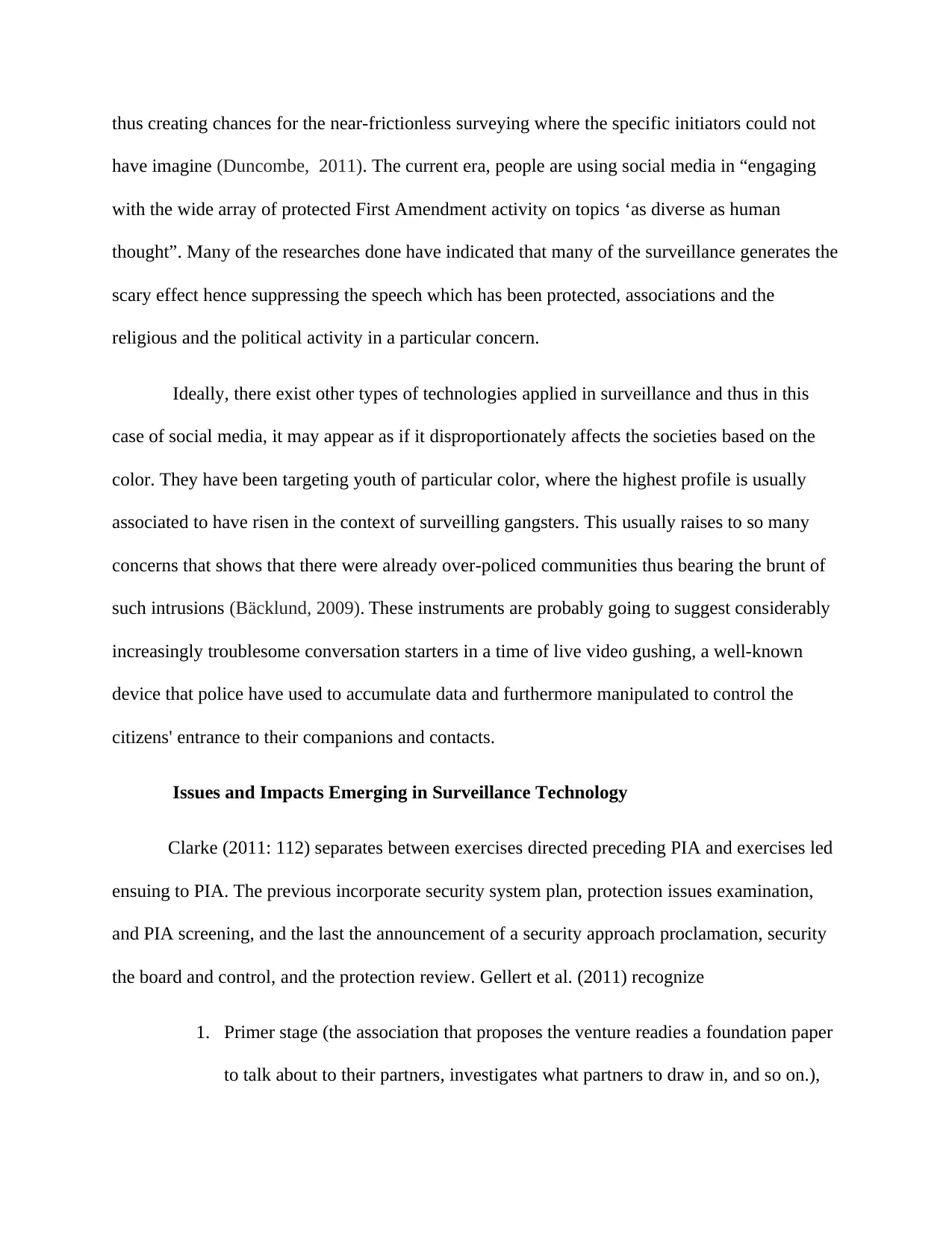
thus creating chances for the near-frictionless surveying where the specific initiators could not
have imagine (Duncombe, 2011). The current era, people are using social media in “engaging
with the wide array of protected First Amendment activity on topics ‘as diverse as human
thought”. Many of the researches done have indicated that many of the surveillance generates the
scary effect hence suppressing the speech which has been protected, associations and the
religious and the political activity in a particular concern.
Ideally, there exist other types of technologies applied in surveillance and thus in this
case of social media, it may appear as if it disproportionately affects the societies based on the
color. They have been targeting youth of particular color, where the highest profile is usually
associated to have risen in the context of surveilling gangsters. This usually raises to so many
concerns that shows that there were already over-policed communities thus bearing the brunt of
such intrusions (Bäcklund, 2009). These instruments are probably going to suggest considerably
increasingly troublesome conversation starters in a time of live video gushing, a well-known
device that police have used to accumulate data and furthermore manipulated to control the
citizens' entrance to their companions and contacts.
Issues and Impacts Emerging in Surveillance Technology
Clarke (2011: 112) separates between exercises directed preceding PIA and exercises led
ensuing to PIA. The previous incorporate security system plan, protection issues examination,
and PIA screening, and the last the announcement of a security approach proclamation, security
the board and control, and the protection review. Gellert et al. (2011) recognize
1. Primer stage (the association that proposes the venture readies a foundation paper
to talk about to their partners, investigates what partners to draw in, and so on.),
have imagine (Duncombe, 2011). The current era, people are using social media in “engaging
with the wide array of protected First Amendment activity on topics ‘as diverse as human
thought”. Many of the researches done have indicated that many of the surveillance generates the
scary effect hence suppressing the speech which has been protected, associations and the
religious and the political activity in a particular concern.
Ideally, there exist other types of technologies applied in surveillance and thus in this
case of social media, it may appear as if it disproportionately affects the societies based on the
color. They have been targeting youth of particular color, where the highest profile is usually
associated to have risen in the context of surveilling gangsters. This usually raises to so many
concerns that shows that there were already over-policed communities thus bearing the brunt of
such intrusions (Bäcklund, 2009). These instruments are probably going to suggest considerably
increasingly troublesome conversation starters in a time of live video gushing, a well-known
device that police have used to accumulate data and furthermore manipulated to control the
citizens' entrance to their companions and contacts.
Issues and Impacts Emerging in Surveillance Technology
Clarke (2011: 112) separates between exercises directed preceding PIA and exercises led
ensuing to PIA. The previous incorporate security system plan, protection issues examination,
and PIA screening, and the last the announcement of a security approach proclamation, security
the board and control, and the protection review. Gellert et al. (2011) recognize
1. Primer stage (the association that proposes the venture readies a foundation paper
to talk about to their partners, investigates what partners to draw in, and so on.),
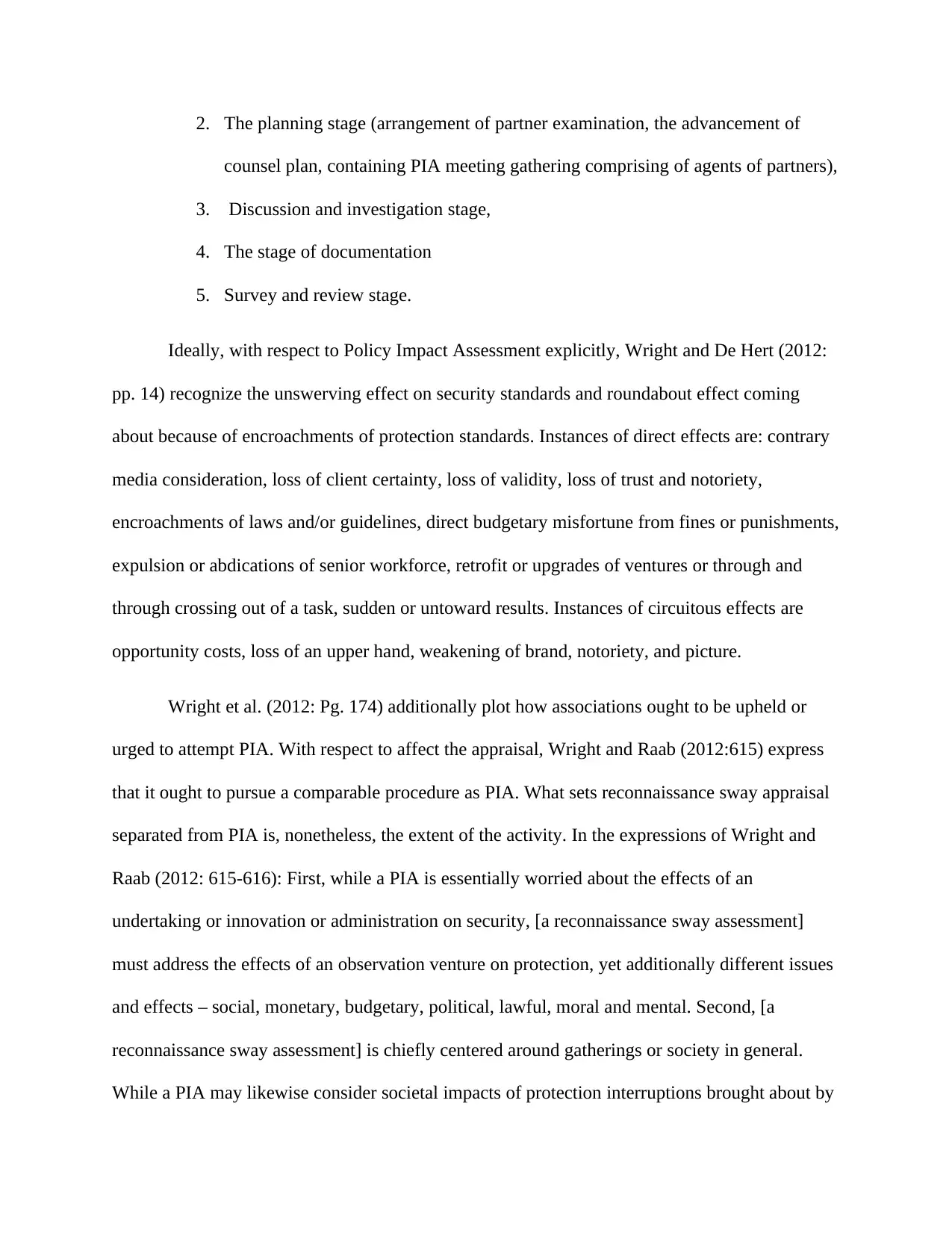
2. The planning stage (arrangement of partner examination, the advancement of
counsel plan, containing PIA meeting gathering comprising of agents of partners),
3. Discussion and investigation stage,
4. The stage of documentation
5. Survey and review stage.
Ideally, with respect to Policy Impact Assessment explicitly, Wright and De Hert (2012:
pp. 14) recognize the unswerving effect on security standards and roundabout effect coming
about because of encroachments of protection standards. Instances of direct effects are: contrary
media consideration, loss of client certainty, loss of validity, loss of trust and notoriety,
encroachments of laws and/or guidelines, direct budgetary misfortune from fines or punishments,
expulsion or abdications of senior workforce, retrofit or upgrades of ventures or through and
through crossing out of a task, sudden or untoward results. Instances of circuitous effects are
opportunity costs, loss of an upper hand, weakening of brand, notoriety, and picture.
Wright et al. (2012: Pg. 174) additionally plot how associations ought to be upheld or
urged to attempt PIA. With respect to affect the appraisal, Wright and Raab (2012:615) express
that it ought to pursue a comparable procedure as PIA. What sets reconnaissance sway appraisal
separated from PIA is, nonetheless, the extent of the activity. In the expressions of Wright and
Raab (2012: 615-616): First, while a PIA is essentially worried about the effects of an
undertaking or innovation or administration on security, [a reconnaissance sway assessment]
must address the effects of an observation venture on protection, yet additionally different issues
and effects – social, monetary, budgetary, political, lawful, moral and mental. Second, [a
reconnaissance sway assessment] is chiefly centered around gatherings or society in general.
While a PIA may likewise consider societal impacts of protection interruptions brought about by
counsel plan, containing PIA meeting gathering comprising of agents of partners),
3. Discussion and investigation stage,
4. The stage of documentation
5. Survey and review stage.
Ideally, with respect to Policy Impact Assessment explicitly, Wright and De Hert (2012:
pp. 14) recognize the unswerving effect on security standards and roundabout effect coming
about because of encroachments of protection standards. Instances of direct effects are: contrary
media consideration, loss of client certainty, loss of validity, loss of trust and notoriety,
encroachments of laws and/or guidelines, direct budgetary misfortune from fines or punishments,
expulsion or abdications of senior workforce, retrofit or upgrades of ventures or through and
through crossing out of a task, sudden or untoward results. Instances of circuitous effects are
opportunity costs, loss of an upper hand, weakening of brand, notoriety, and picture.
Wright et al. (2012: Pg. 174) additionally plot how associations ought to be upheld or
urged to attempt PIA. With respect to affect the appraisal, Wright and Raab (2012:615) express
that it ought to pursue a comparable procedure as PIA. What sets reconnaissance sway appraisal
separated from PIA is, nonetheless, the extent of the activity. In the expressions of Wright and
Raab (2012: 615-616): First, while a PIA is essentially worried about the effects of an
undertaking or innovation or administration on security, [a reconnaissance sway assessment]
must address the effects of an observation venture on protection, yet additionally different issues
and effects – social, monetary, budgetary, political, lawful, moral and mental. Second, [a
reconnaissance sway assessment] is chiefly centered around gatherings or society in general.
While a PIA may likewise consider societal impacts of protection interruptions brought about by
⊘ This is a preview!⊘
Do you want full access?
Subscribe today to unlock all pages.

Trusted by 1+ million students worldwide

another innovation, task or administration, it's beginning stage is the person. Third, in light of the
fact that [an observation sway assessment] must address a more extensive scope of effects, so too
should it counsel and connect with a more extensive scope of partners than a PIA.
Any observation sway evaluation, so the creators proceed (Wright and Raab 2012: 616-
617) should begin by portraying the reconnaissance advancements being referred to, which
incorporates the detail the sorts of observation that the innovation is made to, or is probably
going to, take part in: is the observation: - incognito or obvious? - watching, "tuning in",
identifying? - does it draw on biometrics, following through space (for example geotagging),
dataveillance? The effects well on the way to rise up out of reconnaissance innovations or
observation practices are (cf. Wright and Raab 2012: 617-620): - singular protection issue and
effects - social issues and effects - monetary and money related issues and effects - political
issues and effects - lawful issues and effects - moral issues and effects - mental effects The
creators at that point likewise give a diagram of what sorts of partners will typically be included,
and how (Wright and Raab 2012: 620-623).
Recommendations
Surveillance is not bad or a bad concept, the only problem is infringing to the citizen
privacies. One privacy is very important as one can be able to live peacefully knowing that they
are not monitored. Surveillance on the social media may be interpreted as spying citizens on their
rights to use social media and thus making them feel that the enforcement law agencies are
misusing their power. Ideally, this should be addressed in a manner that all the citizens know
their existence and that the technology is transparent and accountable.
fact that [an observation sway assessment] must address a more extensive scope of effects, so too
should it counsel and connect with a more extensive scope of partners than a PIA.
Any observation sway evaluation, so the creators proceed (Wright and Raab 2012: 616-
617) should begin by portraying the reconnaissance advancements being referred to, which
incorporates the detail the sorts of observation that the innovation is made to, or is probably
going to, take part in: is the observation: - incognito or obvious? - watching, "tuning in",
identifying? - does it draw on biometrics, following through space (for example geotagging),
dataveillance? The effects well on the way to rise up out of reconnaissance innovations or
observation practices are (cf. Wright and Raab 2012: 617-620): - singular protection issue and
effects - social issues and effects - monetary and money related issues and effects - political
issues and effects - lawful issues and effects - moral issues and effects - mental effects The
creators at that point likewise give a diagram of what sorts of partners will typically be included,
and how (Wright and Raab 2012: 620-623).
Recommendations
Surveillance is not bad or a bad concept, the only problem is infringing to the citizen
privacies. One privacy is very important as one can be able to live peacefully knowing that they
are not monitored. Surveillance on the social media may be interpreted as spying citizens on their
rights to use social media and thus making them feel that the enforcement law agencies are
misusing their power. Ideally, this should be addressed in a manner that all the citizens know
their existence and that the technology is transparent and accountable.
Paraphrase This Document
Need a fresh take? Get an instant paraphrase of this document with our AI Paraphraser
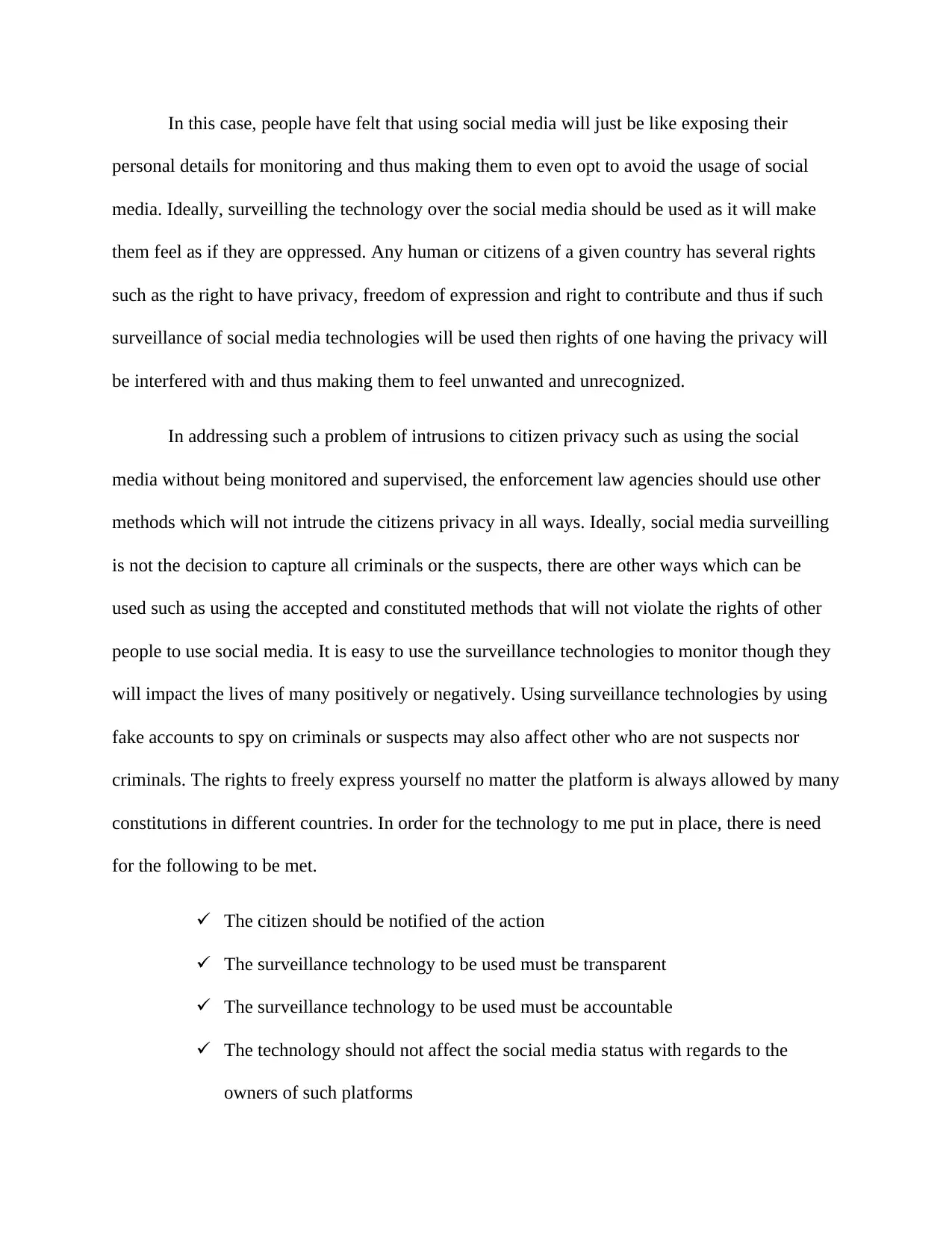
In this case, people have felt that using social media will just be like exposing their
personal details for monitoring and thus making them to even opt to avoid the usage of social
media. Ideally, surveilling the technology over the social media should be used as it will make
them feel as if they are oppressed. Any human or citizens of a given country has several rights
such as the right to have privacy, freedom of expression and right to contribute and thus if such
surveillance of social media technologies will be used then rights of one having the privacy will
be interfered with and thus making them to feel unwanted and unrecognized.
In addressing such a problem of intrusions to citizen privacy such as using the social
media without being monitored and supervised, the enforcement law agencies should use other
methods which will not intrude the citizens privacy in all ways. Ideally, social media surveilling
is not the decision to capture all criminals or the suspects, there are other ways which can be
used such as using the accepted and constituted methods that will not violate the rights of other
people to use social media. It is easy to use the surveillance technologies to monitor though they
will impact the lives of many positively or negatively. Using surveillance technologies by using
fake accounts to spy on criminals or suspects may also affect other who are not suspects nor
criminals. The rights to freely express yourself no matter the platform is always allowed by many
constitutions in different countries. In order for the technology to me put in place, there is need
for the following to be met.
The citizen should be notified of the action
The surveillance technology to be used must be transparent
The surveillance technology to be used must be accountable
The technology should not affect the social media status with regards to the
owners of such platforms
personal details for monitoring and thus making them to even opt to avoid the usage of social
media. Ideally, surveilling the technology over the social media should be used as it will make
them feel as if they are oppressed. Any human or citizens of a given country has several rights
such as the right to have privacy, freedom of expression and right to contribute and thus if such
surveillance of social media technologies will be used then rights of one having the privacy will
be interfered with and thus making them to feel unwanted and unrecognized.
In addressing such a problem of intrusions to citizen privacy such as using the social
media without being monitored and supervised, the enforcement law agencies should use other
methods which will not intrude the citizens privacy in all ways. Ideally, social media surveilling
is not the decision to capture all criminals or the suspects, there are other ways which can be
used such as using the accepted and constituted methods that will not violate the rights of other
people to use social media. It is easy to use the surveillance technologies to monitor though they
will impact the lives of many positively or negatively. Using surveillance technologies by using
fake accounts to spy on criminals or suspects may also affect other who are not suspects nor
criminals. The rights to freely express yourself no matter the platform is always allowed by many
constitutions in different countries. In order for the technology to me put in place, there is need
for the following to be met.
The citizen should be notified of the action
The surveillance technology to be used must be transparent
The surveillance technology to be used must be accountable
The technology should not affect the social media status with regards to the
owners of such platforms

Law enforcement agencies should be working against the rules set in setting the
notifications, but should work according to the extent that has been set in making
this a success.
It is good for the government to retain and build its trust to its citizens by involving them in their
projects and thus this will help them in giving new suggestions that can help them to achieve the
objectives of using such a technology. Notably, people are ruled by the government and thus the
ruling body act as the voice of the people which makes them to be reliable in case a nation goes
in chaos.
Conclusion
In conclusion, we infer that the center worries of societal effect evaluation – in each
articulation, SIA, CTA, PIA, or observation sway appraisal – ought to be to render control
differentials noticeable and put them on the plan. Close by Arie Rip and others we buy into the
possibility that exchange among various people and gatherings who are considered, or think
about themselves, as conceivably influenced by an arranged venture, is an advantage in itself.
Evaluation principles for societal effects ought to be deliberately viewed as rules and take into
consideration adequate adaptability to suit the particular needs of every appraisal venture. In this
soul, the primary result of ASSERT ought to be an asset that requires and structures basic
reflection, managing and encouraging the leaders of societal effect appraisal without making
extra review structures and organizations.
notifications, but should work according to the extent that has been set in making
this a success.
It is good for the government to retain and build its trust to its citizens by involving them in their
projects and thus this will help them in giving new suggestions that can help them to achieve the
objectives of using such a technology. Notably, people are ruled by the government and thus the
ruling body act as the voice of the people which makes them to be reliable in case a nation goes
in chaos.
Conclusion
In conclusion, we infer that the center worries of societal effect evaluation – in each
articulation, SIA, CTA, PIA, or observation sway appraisal – ought to be to render control
differentials noticeable and put them on the plan. Close by Arie Rip and others we buy into the
possibility that exchange among various people and gatherings who are considered, or think
about themselves, as conceivably influenced by an arranged venture, is an advantage in itself.
Evaluation principles for societal effects ought to be deliberately viewed as rules and take into
consideration adequate adaptability to suit the particular needs of every appraisal venture. In this
soul, the primary result of ASSERT ought to be an asset that requires and structures basic
reflection, managing and encouraging the leaders of societal effect appraisal without making
extra review structures and organizations.
⊘ This is a preview!⊘
Do you want full access?
Subscribe today to unlock all pages.

Trusted by 1+ million students worldwide
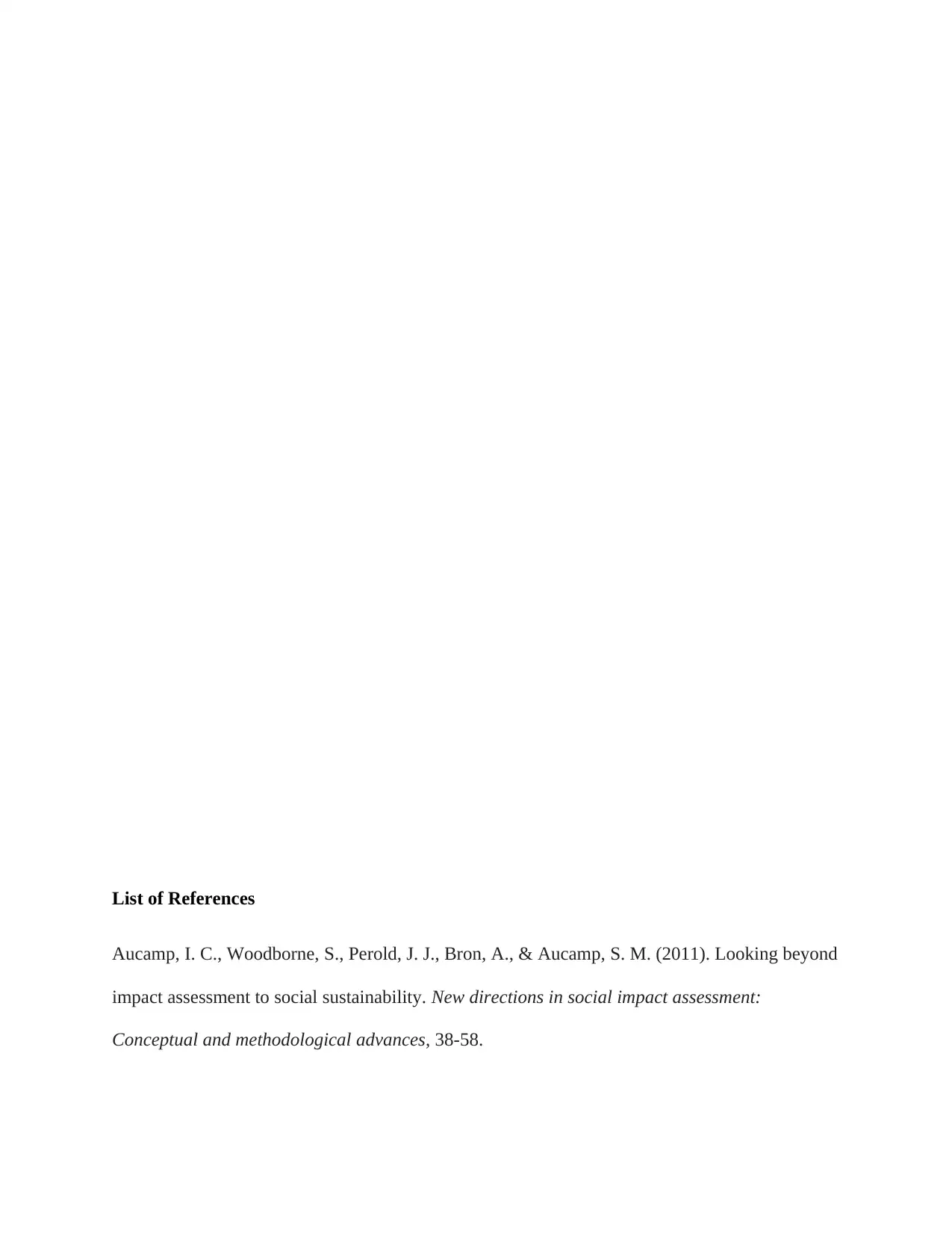
List of References
Aucamp, I. C., Woodborne, S., Perold, J. J., Bron, A., & Aucamp, S. M. (2011). Looking beyond
impact assessment to social sustainability. New directions in social impact assessment:
Conceptual and methodological advances, 38-58.
Aucamp, I. C., Woodborne, S., Perold, J. J., Bron, A., & Aucamp, S. M. (2011). Looking beyond
impact assessment to social sustainability. New directions in social impact assessment:
Conceptual and methodological advances, 38-58.
Paraphrase This Document
Need a fresh take? Get an instant paraphrase of this document with our AI Paraphraser
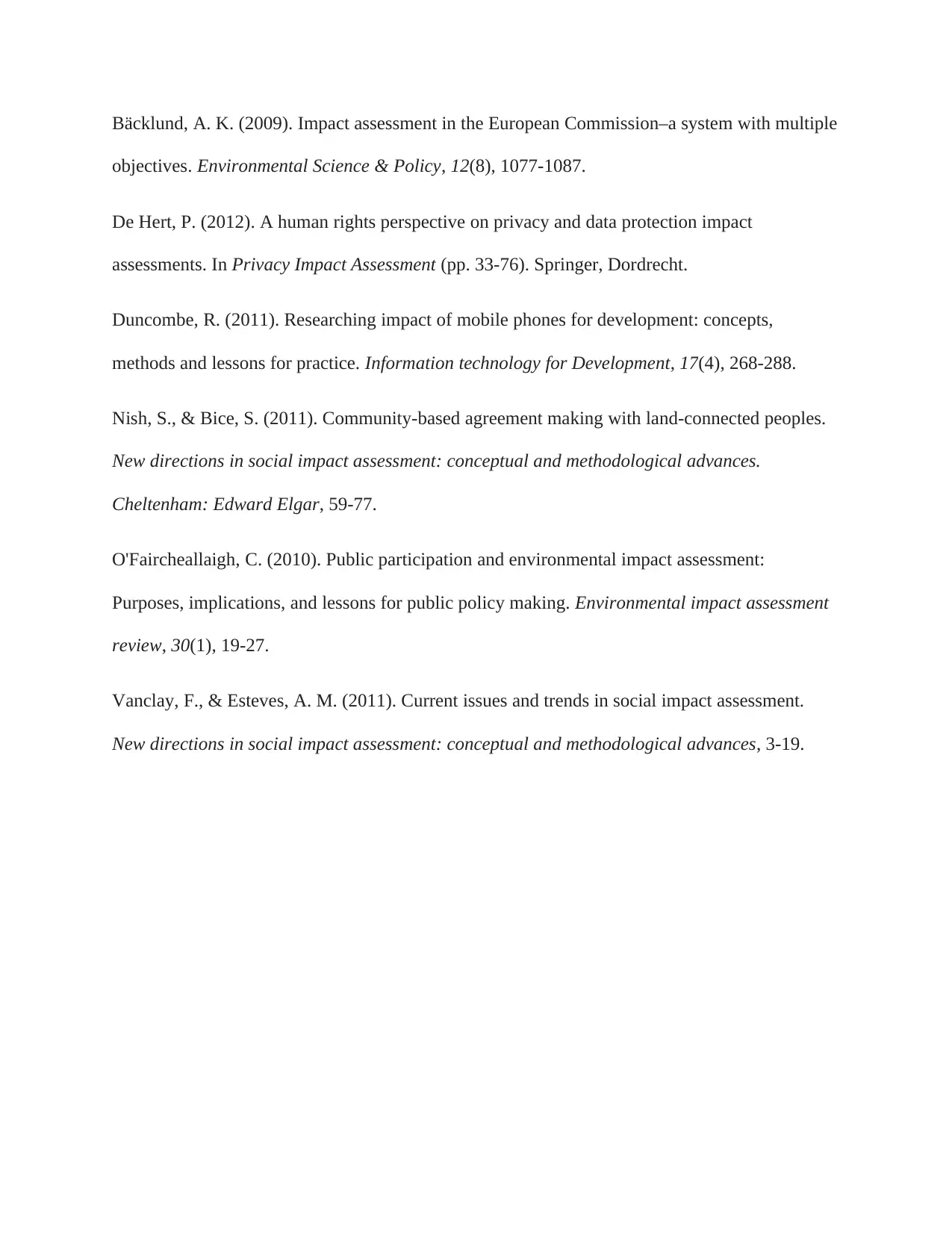
Bäcklund, A. K. (2009). Impact assessment in the European Commission–a system with multiple
objectives. Environmental Science & Policy, 12(8), 1077-1087.
De Hert, P. (2012). A human rights perspective on privacy and data protection impact
assessments. In Privacy Impact Assessment (pp. 33-76). Springer, Dordrecht.
Duncombe, R. (2011). Researching impact of mobile phones for development: concepts,
methods and lessons for practice. Information technology for Development, 17(4), 268-288.
Nish, S., & Bice, S. (2011). Community-based agreement making with land-connected peoples.
New directions in social impact assessment: conceptual and methodological advances.
Cheltenham: Edward Elgar, 59-77.
O'Faircheallaigh, C. (2010). Public participation and environmental impact assessment:
Purposes, implications, and lessons for public policy making. Environmental impact assessment
review, 30(1), 19-27.
Vanclay, F., & Esteves, A. M. (2011). Current issues and trends in social impact assessment.
New directions in social impact assessment: conceptual and methodological advances, 3-19.
objectives. Environmental Science & Policy, 12(8), 1077-1087.
De Hert, P. (2012). A human rights perspective on privacy and data protection impact
assessments. In Privacy Impact Assessment (pp. 33-76). Springer, Dordrecht.
Duncombe, R. (2011). Researching impact of mobile phones for development: concepts,
methods and lessons for practice. Information technology for Development, 17(4), 268-288.
Nish, S., & Bice, S. (2011). Community-based agreement making with land-connected peoples.
New directions in social impact assessment: conceptual and methodological advances.
Cheltenham: Edward Elgar, 59-77.
O'Faircheallaigh, C. (2010). Public participation and environmental impact assessment:
Purposes, implications, and lessons for public policy making. Environmental impact assessment
review, 30(1), 19-27.
Vanclay, F., & Esteves, A. M. (2011). Current issues and trends in social impact assessment.
New directions in social impact assessment: conceptual and methodological advances, 3-19.
1 out of 11
Related Documents
Your All-in-One AI-Powered Toolkit for Academic Success.
+13062052269
info@desklib.com
Available 24*7 on WhatsApp / Email
![[object Object]](/_next/static/media/star-bottom.7253800d.svg)
Unlock your academic potential
Copyright © 2020–2025 A2Z Services. All Rights Reserved. Developed and managed by ZUCOL.





